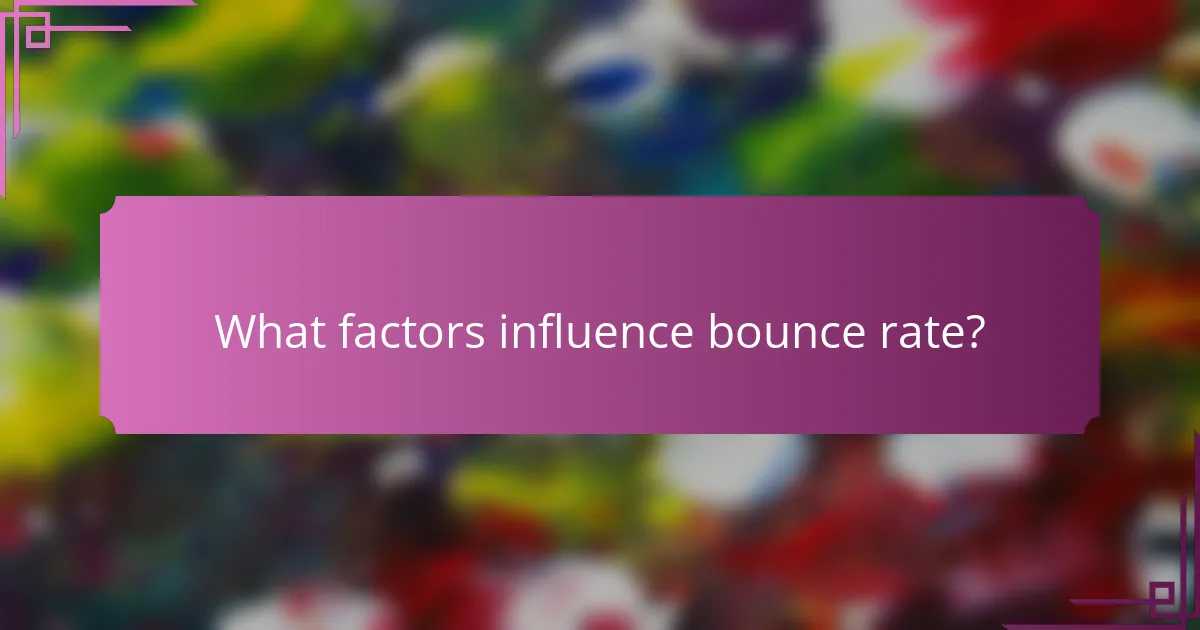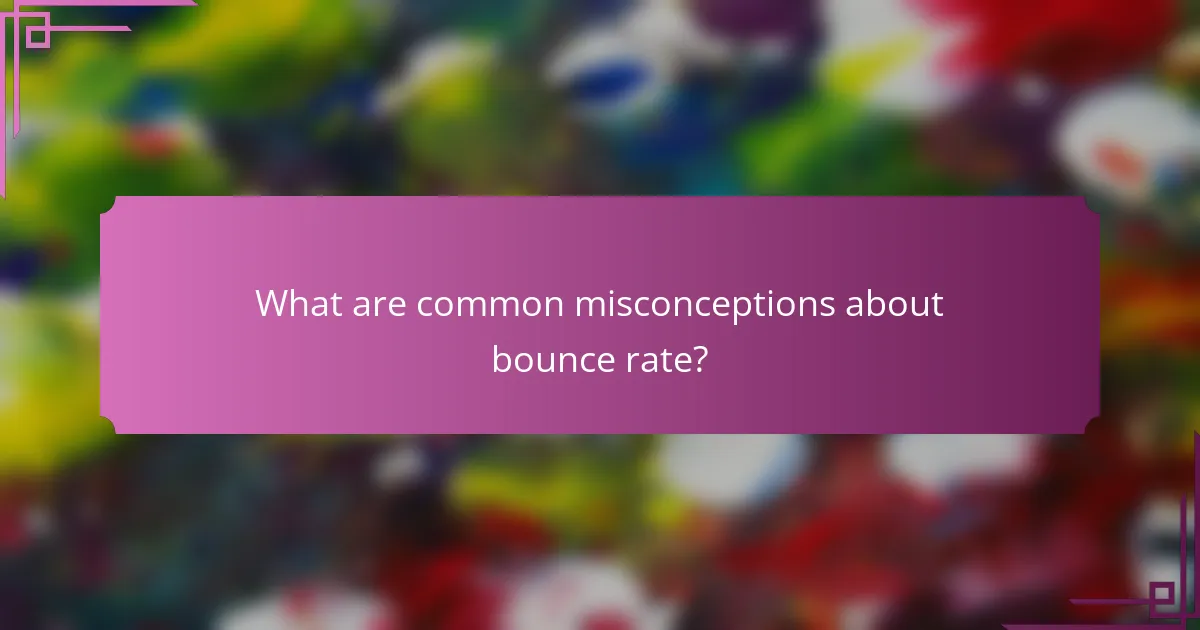Bounce rate is a crucial metric that measures the percentage of visitors who leave a website after viewing only one page. A high bounce rate can signal that the landing page fails to meet user expectations, highlighting the need for improvements in design, content quality, and overall user experience. By focusing on strategies to enhance engagement, website owners can effectively reduce bounce rates and foster a more satisfying visitor experience.

How can I improve my website’s bounce rate?
To improve your website’s bounce rate, focus on enhancing user engagement and satisfaction. This can be achieved through optimizing page load speed, ensuring content relevance, and improving overall user experience.
Optimize page load speed
Page load speed is crucial for retaining visitors. Aim for a load time of under 3 seconds, as slower speeds can lead to higher bounce rates. Use tools like Google PageSpeed Insights to identify areas for improvement.
Consider optimizing images, leveraging browser caching, and minimizing JavaScript to enhance speed. Regularly test your site’s performance across different devices and networks to ensure consistent user experience.
Enhance content relevance
Content relevance directly impacts user engagement. Ensure that your content aligns with the expectations set by your headlines and meta descriptions. Conduct keyword research to understand what your audience is searching for.
Regularly update your content to keep it fresh and relevant. Use analytics to track which topics resonate most with your audience, and adjust your content strategy accordingly.
Improve user experience design
A well-designed website enhances user experience and reduces bounce rates. Focus on intuitive navigation, clear layouts, and mobile responsiveness. Ensure that users can easily find what they are looking for without frustration.
Utilize whitespace effectively to avoid clutter and make your content more digestible. Conduct user testing to gather feedback on design elements and make necessary adjustments based on user behavior.
Utilize engaging multimedia
Incorporating multimedia elements like images, videos, and infographics can significantly enhance user engagement. These elements can break up text and provide visual interest, making your content more appealing.
Ensure that multimedia is relevant and adds value to the content rather than distracting from it. Optimize file sizes to maintain fast loading times while still delivering quality visuals.
Implement clear calls to action
Clear calls to action (CTAs) guide users on what to do next, reducing bounce rates. Use concise, action-oriented language that encourages users to engage further with your site.
Place CTAs strategically throughout your content, ensuring they are visible and compelling. Test different wording and placements to determine what resonates best with your audience.

What is bounce rate?
Bounce rate is the percentage of visitors who leave a website after viewing only one page, without engaging further. A high bounce rate often indicates that the landing page did not meet the visitor’s expectations or needs.
Definition of bounce rate
The bounce rate is calculated by dividing the number of single-page visits by the total number of entries to a website. For example, if a site receives 100 visitors and 40 leave after viewing just one page, the bounce rate would be 40%. This metric helps assess user engagement and content effectiveness.
Understanding bounce rate is crucial for website optimization. A low bounce rate, typically below 40%, suggests that users find the content relevant and are encouraged to explore more pages. Conversely, a high bounce rate may signal issues with content quality, page load speed, or user experience.
Importance in digital marketing
Bounce rate plays a significant role in digital marketing as it directly impacts conversion rates and overall site performance. A high bounce rate can lead to lower search engine rankings, as search engines interpret it as a sign of poor content or user experience.
Marketers can use bounce rate data to identify underperforming pages and make necessary adjustments. For instance, improving page load times, enhancing content relevancy, or optimizing calls to action can help reduce bounce rates and increase user engagement.
Regularly monitoring bounce rate alongside other metrics, such as average session duration and conversion rates, provides a comprehensive view of website performance. This holistic approach enables marketers to implement targeted strategies for improvement.

What factors influence bounce rate?
Bounce rate is influenced by several key factors, including page design, content quality, and user demographics. Understanding these elements can help website owners identify areas for improvement and reduce bounce rates effectively.
Page design and layout
The design and layout of a webpage significantly impact bounce rate. A clean, intuitive design encourages users to explore further, while cluttered or confusing layouts can lead to quick exits. Ensure that navigation is straightforward and that important information is easily accessible.
Consider using responsive design to accommodate various devices, as mobile users are increasingly prevalent. Websites that load quickly and have visually appealing elements tend to retain visitors longer.
Content quality and relevance
High-quality, relevant content is crucial for keeping visitors engaged. If users find the information they seek quickly, they are more likely to stay on the site. Content should be well-written, informative, and tailored to the target audience’s interests and needs.
Regularly updating content and ensuring it aligns with user intent can also help reduce bounce rates. Utilize analytics to identify which topics resonate most with your audience and focus on those areas.
User demographics and behavior
User demographics and behavior play a significant role in bounce rate. Different age groups, interests, and geographical locations may have varying expectations and browsing habits. Understanding your audience can help tailor content and design to meet their preferences.
Utilize tools like Google Analytics to gather insights on user behavior. This data can inform adjustments to content and layout, ultimately leading to a more engaging experience that encourages users to stay longer on your site.

How does bounce rate affect display advertising?
Bounce rate significantly impacts display advertising by influencing both ad performance and revenue. A high bounce rate indicates that visitors leave a site quickly, which can lead to lower engagement with ads and reduced earnings for publishers.
Impact on ad performance
A high bounce rate can negatively affect ad performance metrics such as click-through rates (CTR) and conversion rates. When users leave a page without interacting, the effectiveness of the ads displayed diminishes, resulting in fewer clicks and lower engagement. Advertisers may see a drop in their return on investment (ROI) if their ads are shown on sites with high bounce rates.
To improve ad performance, website owners should focus on enhancing user experience. This can include optimizing page load times, improving content relevance, and ensuring mobile-friendliness. Regularly analyzing user behavior can help identify areas for improvement.
Influence on ad revenue
Bounce rate directly affects ad revenue, as advertisers are less likely to invest in placements on sites with high bounce rates. If visitors are not engaging with the content, advertisers may perceive the site as ineffective, leading to lower ad rates or fewer ad placements. This can significantly impact overall earnings for publishers.
To mitigate revenue loss, publishers should consider implementing strategies to retain visitors longer. Techniques such as offering engaging content, using clear calls to action, and improving site navigation can help lower bounce rates and, consequently, enhance ad revenue. Regularly testing different ad placements and formats can also provide insights into what works best for retaining audience attention.

What tools can help analyze bounce rate?
Several tools can effectively analyze bounce rate, providing insights into user engagement and website performance. Utilizing these tools can help identify areas for improvement and enhance overall user experience.
Google Analytics
Google Analytics is a powerful tool for tracking bounce rate, offering detailed insights into user behavior on your website. It allows you to segment data by various dimensions such as traffic source, device type, and user demographics, helping you understand which areas need attention.
To effectively use Google Analytics, set up goals and track events that indicate user engagement. This can provide a clearer picture of what constitutes a bounce versus meaningful interaction.
Hotjar
Hotjar complements traditional analytics by providing heatmaps and session recordings, which visually represent user interactions on your site. This can help identify why users are bouncing by revealing where they click, scroll, or lose interest.
Using Hotjar, you can gather qualitative data through user feedback tools like surveys and polls. This feedback can guide adjustments to content or layout, potentially reducing bounce rates.
Crazy Egg
Crazy Egg offers similar features to Hotjar, including heatmaps and scroll maps, to visualize user engagement. It also provides A/B testing capabilities, allowing you to experiment with different layouts or content to see what keeps users engaged longer.
When using Crazy Egg, focus on analyzing the results of your tests to identify effective strategies that lower bounce rates. Regularly review your findings to adapt your website based on user preferences and behaviors.

What are common misconceptions about bounce rate?
Many people mistakenly believe that a high bounce rate always indicates poor website performance. In reality, a high bounce rate can be acceptable depending on the context, such as when users find the information they need quickly and leave satisfied.
High bounce rate equals poor content quality
A common misconception is that a high bounce rate directly correlates with low content quality. While poor content can lead to higher bounces, other factors such as user intent and the type of page can also play significant roles. For example, a landing page designed to provide specific information may have a high bounce rate but still serve its purpose effectively.
All bounces are bad
Not all bounces are detrimental to your website’s success. For instance, if a visitor lands on a contact page, finds the information they need, and leaves, this is a successful interaction. Understanding the context of each bounce is crucial for evaluating its impact on overall performance.
Bounce rate is the only metric that matters
Focusing solely on bounce rate can lead to a skewed understanding of user engagement. It’s essential to consider other metrics, such as average session duration and conversion rates, to gain a comprehensive view of how users interact with your site. A balanced approach to analytics will provide better insights into user behavior.


